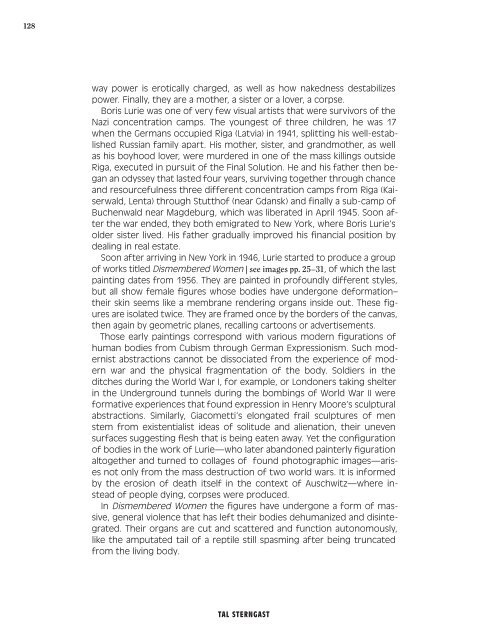The Art of
Katalog_Boris-Lurie_English
Katalog_Boris-Lurie_English
Create successful ePaper yourself
Turn your PDF publications into a flip-book with our unique Google optimized e-Paper software.
128<br />
way power is erotically charged, as well as how nakedness destabilizes<br />
power. Finally, they are a mother, a sister or a lover, a corpse.<br />
Boris Lurie was one <strong>of</strong> very few visual artists that were survivors <strong>of</strong> the<br />
Nazi concentration camps. <strong>The</strong> youngest <strong>of</strong> three children, he was 17<br />
when the Germans occupied Riga (Latvia) in 1941, splitting his well-established<br />
Russian family apart. His mother, sister, and grandmother, as well<br />
as his boyhood lover, were murdered in one <strong>of</strong> the mass killings outside<br />
Riga, executed in pursuit <strong>of</strong> the Final Solution. He and his father then began<br />
an odyssey that lasted four years, surviving together through chance<br />
and resourcefulness three different concentration camps from Riga (Kaiserwald,<br />
Lenta) through Stutth<strong>of</strong> (near Gdansk) and finally a sub-camp <strong>of</strong><br />
Buchenwald near Magdeburg, which was liberated in April 1945. Soon after<br />
the war ended, they both emigrated to New York, where Boris Lurie’s<br />
older sister lived. His father gradually improved his financial position by<br />
dealing in real estate.<br />
Soon after arriving in New York in 1946, Lurie started to produce a group<br />
<strong>of</strong> works titled Dismembered Women | see images pp. 25–31, <strong>of</strong> which the last<br />
painting dates from 1956. <strong>The</strong>y are painted in pr<strong>of</strong>oundly different styles,<br />
but all show female figures whose bodies have undergone deformation–<br />
their skin seems like a membrane rendering organs inside out. <strong>The</strong>se figures<br />
are isolated twice. <strong>The</strong>y are framed once by the borders <strong>of</strong> the canvas,<br />
then again by geometric planes, recalling cartoons or advertisements.<br />
Those early paintings correspond with various modern figurations <strong>of</strong><br />
human bodies from Cubism through German Expressionism. Such modernist<br />
abstractions cannot be dissociated from the experience <strong>of</strong> modern<br />
war and the physical fragmentation <strong>of</strong> the body. Soldiers in the<br />
ditches during the World War I, for example, or Londoners taking shelter<br />
in the Underground tunnels during the bombings <strong>of</strong> World War II were<br />
formative experiences that found expression in Henry Moore’s sculptural<br />
abstractions. Similarly, Giacometti’s elongated frail sculptures <strong>of</strong> men<br />
stem from existentialist ideas <strong>of</strong> solitude and alienation, their uneven<br />
surfaces suggesting flesh that is being eaten away. Yet the configuration<br />
<strong>of</strong> bodies in the work <strong>of</strong> Lurie—who later abandoned painterly figuration<br />
altogether and turned to collages <strong>of</strong> found photographic images—arises<br />
not only from the mass destruction <strong>of</strong> two world wars. It is informed<br />
by the erosion <strong>of</strong> death itself in the context <strong>of</strong> Auschwitz—where instead<br />
<strong>of</strong> people dying, corpses were produced.<br />
In Dismembered Women the figures have undergone a form <strong>of</strong> massive,<br />
general violence that has left their bodies dehumanized and disintegrated.<br />
<strong>The</strong>ir organs are cut and scattered and function autonomously,<br />
like the amputated tail <strong>of</strong> a reptile still spasming after being truncated<br />
from the living body.<br />
TAL STERNGAST



